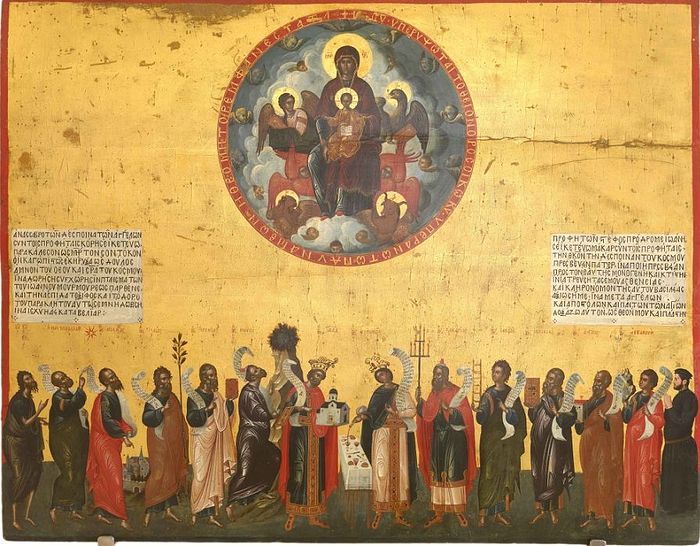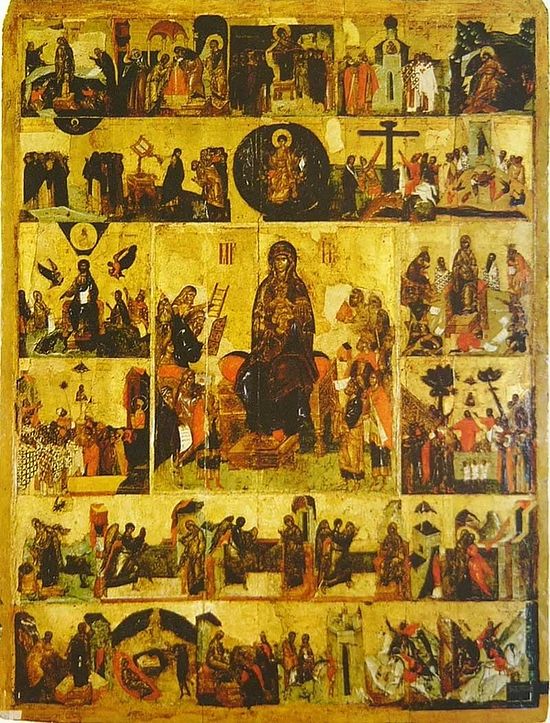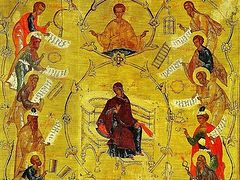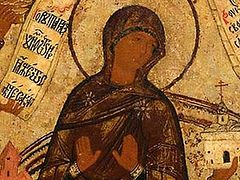 Salutations of the Theotokos, the Apostles. Cretan school. Venice, Italy. 16th C.. Photo: ruvera.ru
Salutations of the Theotokos, the Apostles. Cretan school. Venice, Italy. 16th C.. Photo: ruvera.ru
On Saturday of the fifth week of Great Lent the holy Church solemnly chants the supplicatory hymn of the Akathist, or praise of thanksgiving of the Most Holy Theotokos. This feast was established in the ninth century for all the times that Constantinople was saved from invasions by its enemies through the help and intercessions of the Most Holy Theotokos.
In the reign of Heraclius in 626, the Persians were edging into the Royal City from the East, and the Scythes and Avars from the West. Then Patriarch Sergius, taking up the Hogiditria icon and robe of the Most Holy Theotokos, made a cross procession along the walls of the city. When he dipped the robe into the waters of the straight, the sea boiled and the enemies’ ships sank. The people spent the whole night in prayer in the Blachernae Church, singing their gratitude to the Mother of God—the Akathist, which translates as, “not sitting”—that is, it is sung standing.
 The Greeks repel the Arabs. 677-78. the Chronicle of John Skylitzes. Photo: ruvera.ru
The Greeks repel the Arabs. 677-78. the Chronicle of John Skylitzes. Photo: ruvera.ru
The Royal City’s second deliverance from the Hagarenes [Arabs] was under Constantine IV Pogonatos in 670, and the third was under Leo the Isaurian (716–740), or according to other sources, under Michael III (864) from the Hagarenes and Scythes—the distant ancestors of Russians, Askold and Dir. It is important to note that their unexpected and total defeat made the Slavic warriors seriously think about God’s taking the side of the Christians, and all the more providentially encouraged a portion of them to convert to Holy Orthodoxy.
Emperor Constantine the Great, the founder of Constantinople, dedicated the city to the Mother of God and considered the Most Holy Virgin to be his own protectress and that of the new capital city. Many churches in honor of the Mother of God were raised up in Constantinople. In the Blachernae Church her holy icon painted by the holy Evangelist Luke was kept. On the night when the united forces of the Hagarenes and the Persians were encroaching upon the city from sea and land, suddenly a terrible storm broke out that dispersed and sunk the attacking ships. All the rest of the enemies fled in shame. Then the grateful people of the city came to the Blachernae Church and spent all night there standing and singing hymns of praise to the city’s Victorious Defender: “To Thee the Champion Leader we Thy servants dedicate a feast of victory and of thanksgiving, as ones rescued out of sufferings O Theotokos!” And from that time on, in remembrance of such a great miracle, the Orthodox Church established the festival of the Laudation of the Most Holy Theotokos.
At first the feast of the Akathist was celebrated in Constantinople in that same Blachernae Church, where were the miracle-working icon of the Mother of God and the sacred items of her earthly life—her robe and cincture; but later the feast was entered into the Typicon of the monasteries founded by St. Savva the Studite and later into the service books of the Church, and from that time on it became a common practice for the entire Eastern Church.
What is the Akathist?
The Akathist is a sacred laudation (praise) of the Most Holy Virgin. It consists of twenty-four hymns, or songs: twelve kontakia and twelve ikoi, spread out according to twenty-four letters of the Greek alphabet. Each hymn begins in the order of its corresponding letter, and each kontakion ends with “Alleluia”, a word from the Psalms, and each ikos ends with the Archangel’s greeting, “Rejoice...”
 Icon of the Salutations of the Mother of God with the Akathist at the Moscow Dormition Cathedral, end of the 14th C.
Icon of the Salutations of the Mother of God with the Akathist at the Moscow Dormition Cathedral, end of the 14th C.
The Akathist consists of twenty-five hymns: thirteen kontakia and twelve ikoi (a “kontakion” is a short hymn of praise; an “ikos” (“house” in Greek) is a broader hymn. The ikoi end with the exclamation “rejoice” and the kontakia end in “Alleluia” (“praise God” in Hebrew).
The entire composition ends in a short prayer to the Most Holy Virgin that she save Christians from troubles and afflictions. The Akathist is read in this form on other days also, but on the Saturday of the fifth week of Great Lent it is part of the service and is sung at Matins (usually on Friday evening), not all at once but divided into sections, in between other hymns, in four different segments. Each segment begins and ends with the hymn from the first kontakion: “To Thee the Champion Leader...” and the rest of the Akathist, which was written in the seventh century, as most believe, by the deacon of the great Constantinople Church George Pisidis, based on stichera by St. Ephraim the Syrian whom we know for his Great Lenten prayer of repentance.1 Later Joseph the Studite wrote the canon for the Saturday of the Akathist, and certain others added prayers of thanksgiving to it in remembrance of the all-powerful leadership of the Mother of God. Our Orthodox Church celebrates this solemnity for the assurance of the penitent of hope in their Heavenly Intercessor, who, having delivered the faithful from visible enemies, is even more ready to help us in our struggle with invisible enemies. Many Akathists—hymns of praise and prayer to the Savior, the Mother of God, and the holy God-pleasing saints—have been written. However the most ancient Akathist to the Most Holy Mother of God was composed in that year of 626 after Constantinople’s deliverance from threatening attacks. This Akathist has served as the example for all those after it.2 This touching Akathist includes both rejoicing and amazement over the lofty perfection of the Most Pure Virgin, her grandeur and beneficence, which she gives to the faithful. Remembering its former deliverance from enemies, the Holy Church in the final days of the Great Fast as if unites it all with prayer to the Most Holy Mother of God for the deliverance of us all from all dangers, so that in seeing the Mother of God as the speedy enabler of our prayers and repentance, we would always remember our heavenly Mediator and Intercessor.
The first kontakion is written in iambic rhyming verse, in each of the ikoi are twelve exclamations of, “Rejoice”, also written in rhyming verse, which also contains consonant words not only at the end but also in the middle of each couplet; and, finally, in each two corresponding verses there are the same number of syllables.3
Iconography of the feast
 The main theme of the icon of the Laudation of the Theotokos is the praise of the Virgin Mary, who, in accordance with the Old Testament prophecies, became the Mother of God incarnate. The basis of the iconography are the words of the canon to the prophets, composed in the eighth century by Constantinople patriarch Germanus: “Higher than the prophets art thou proclaimed, O Maiden: the jar, the rod, the tablet, the ark, the candle stand, the table, the uncut mountain, the golden censer and tabernacle, the impassible door, the palace, and ladder, and throne of the King.” Based on this hymn, the Old Testament prophets are depicted on the icon, holding in their hands specific objects: Jacob with a ladder, Moses with the Burning Bush, Balaam with a star, Gideon with a fleece, Ezekiel with gates, Jeremiah with a tablet, Isaiah with tongs and coal, Jesse and Aaron with budding rods, David and Solomon with models of the Jerusalem temple, and Daniel and Habakkuk with mountains.
The main theme of the icon of the Laudation of the Theotokos is the praise of the Virgin Mary, who, in accordance with the Old Testament prophecies, became the Mother of God incarnate. The basis of the iconography are the words of the canon to the prophets, composed in the eighth century by Constantinople patriarch Germanus: “Higher than the prophets art thou proclaimed, O Maiden: the jar, the rod, the tablet, the ark, the candle stand, the table, the uncut mountain, the golden censer and tabernacle, the impassible door, the palace, and ladder, and throne of the King.” Based on this hymn, the Old Testament prophets are depicted on the icon, holding in their hands specific objects: Jacob with a ladder, Moses with the Burning Bush, Balaam with a star, Gideon with a fleece, Ezekiel with gates, Jeremiah with a tablet, Isaiah with tongs and coal, Jesse and Aaron with budding rods, David and Solomon with models of the Jerusalem temple, and Daniel and Habakkuk with mountains.
The oldest icon in Russia of the Laudation of the Mother of God is the icon of the “Laudation of the Mother of God with the Akathist” from the Moscow Dormition Cathedral, painted by Greek masters in the late fourteenth century.




https://www.youtube.com/watch?v=YldMRoit7wo
And I say again!
REJOICE!